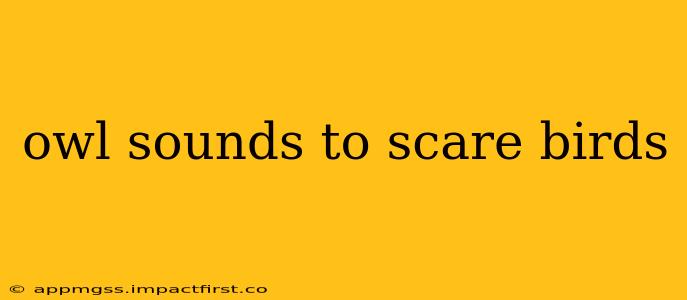Birds are beautiful creatures, but sometimes their presence can be unwelcome, especially in gardens, farms, or around airports. Many people turn to owl sounds as a humane and effective method of bird control. This guide will explore the effectiveness of owl sounds, address common concerns, and provide insights into best practices for using this method.
How Effective Are Owl Sounds in Scaring Birds?
The effectiveness of using owl sounds to deter birds depends on several factors, including the species of bird, their familiarity with owl sounds, the volume and realism of the playback, and the consistency of use. Generally, owl sounds can be effective as a short-term deterrent, especially for birds that are naturally prey to owls. However, birds are intelligent creatures, and they can quickly habituate to repetitive sounds. Continuous use of the same sound without variation can render it ineffective over time.
What Kind of Owl Sounds Work Best?
The most effective owl sounds are those that are realistic and high-quality recordings of actual owl calls. Sounds that mimic the distress calls of birds being attacked by owls are often more effective than just a standard hoot. Look for recordings that offer a range of sounds – a single, repetitive sound is easily habituated to. The best recordings often incorporate a variety of calls, mimicking a hunting owl's behaviors.
Do Owl Sounds Actually Hurt Birds?
No, owl sounds do not physically hurt birds. The purpose is to create a sense of threat and fear, encouraging them to move away from the area. However, prolonged exposure to loud, unnatural sounds can cause stress in birds. It's crucial to use the sounds responsibly and avoid excessive volume or continuous play.
What Are the Best Owl Sound Devices?
Several devices are available, ranging from simple smartphone apps playing owl sounds to more sophisticated electronic repellents that emit a variety of sounds, including owl calls, at varying intervals. The choice depends on your budget and specific needs. Consider factors like sound quality, volume control, and weatherproofing when choosing a device.
How Often Should I Play Owl Sounds?
Playing owl sounds intermittently is generally more effective than continuous playback. Varying the time of day and the frequency of playback will help prevent birds from habituating to the sounds. Consider using the sounds strategically – for example, during dawn and dusk, when birds are most active.
Are There Any Downsides to Using Owl Sounds?
While generally considered humane, using owl sounds has some downsides. As mentioned earlier, consistent use can lead to habituation. Moreover, if the sounds are too loud or played continuously, they can disturb neighbors or even other wildlife. Responsible use and consideration for the surrounding environment are key.
Are There Alternatives to Owl Sounds for Bird Control?
Yes, there are other methods for bird control, including visual deterrents (such as shiny ribbons or reflective tape), physical barriers, and the use of other sounds (such as distress calls of other birds). The best approach often involves a combination of methods tailored to the specific bird species and situation.
Can Owl Sounds Deter All Birds?
No, owl sounds are not universally effective against all bird species. Some birds are less susceptible to the threat of owls due to their size, natural defenses, or prior experience. The effectiveness varies significantly based on the specific bird species.
Are Owl Sounds Legal to Use?
The legality of using owl sounds for bird control can vary depending on local laws and regulations. Always check with your local authorities before using any bird control method. Some areas may have restrictions on sound levels or specific devices.
By understanding the effectiveness, limitations, and responsible use of owl sounds, you can make an informed decision about whether this method is suitable for your specific bird control needs. Remember, a multi-pronged approach often yields the best results, and always prioritize humane and environmentally responsible practices.
